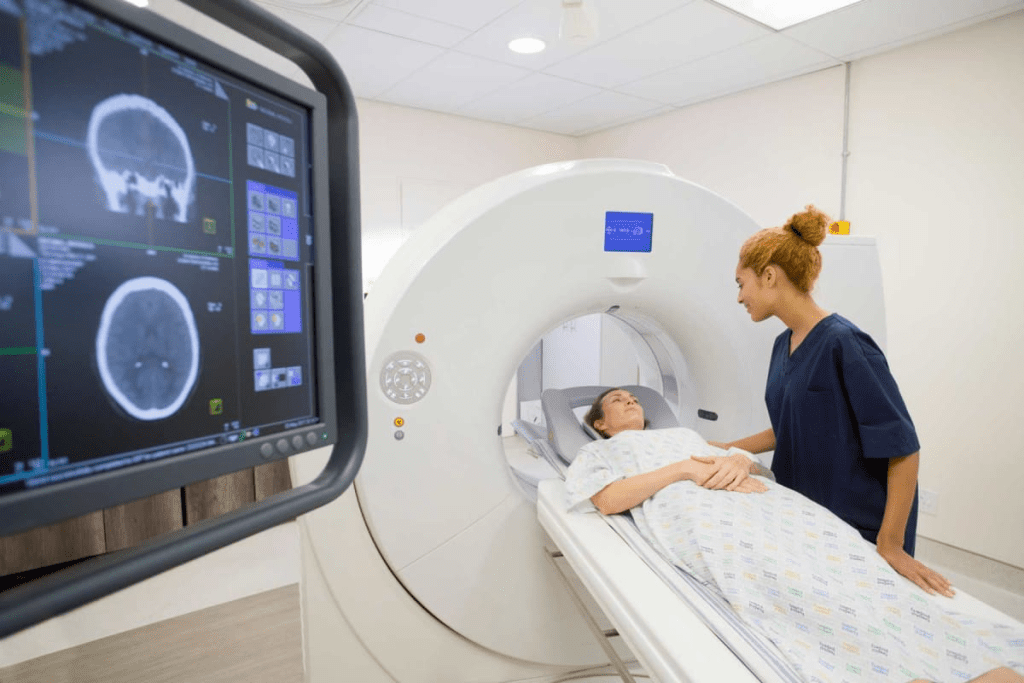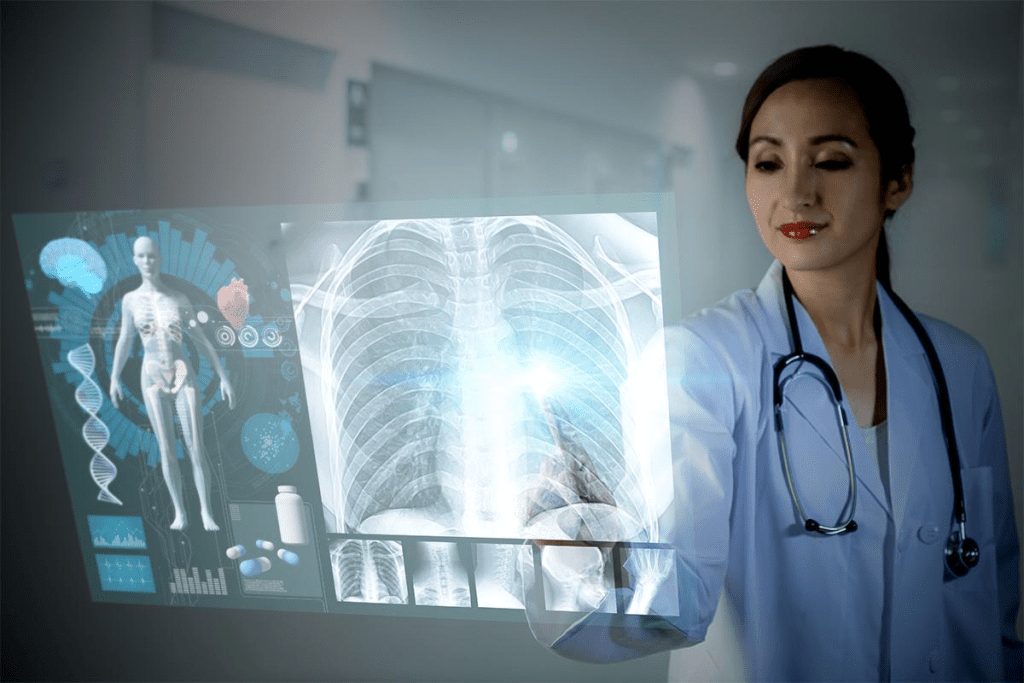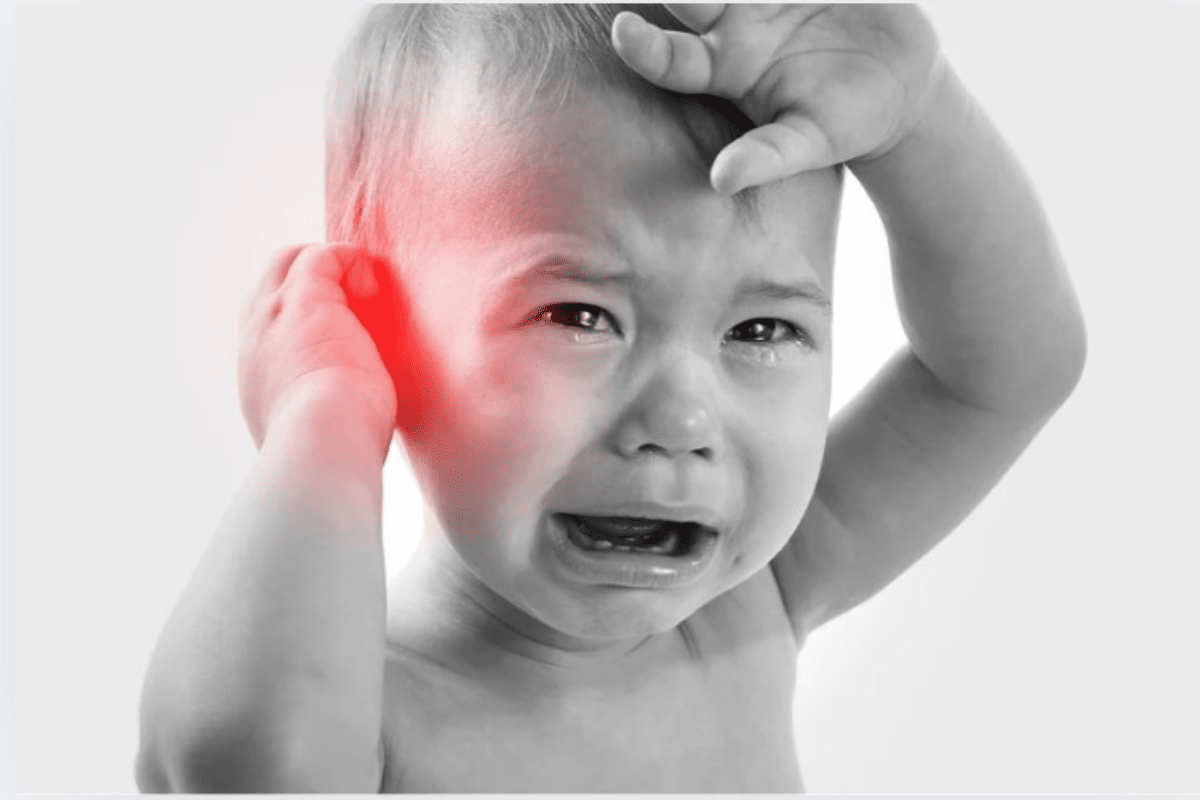Last Updated on November 27, 2025 by Bilal Hasdemir

Medical imaging is key in today’s healthcare. It helps doctors diagnose and treat health issues. X-rays, CT scans, and MRIs are often used. Knowing how they differ is important for accurate diagnoses, like spotting tendon or ligament damage.
At Liv Hospital, we use the latest tech to get the right scan the first time. X-rays give quick, 2D images of bones, but they can’t see soft tissue injuries well. On the other hand, CT scans and MRIs show more detail. CT scans give cross-sectional views, while MRIs show soft tissues better.
Key Takeaways
- Medical imaging is key for diagnosing and treating health problems.
- X-rays, CT scans, and MRIs are the most commonly used radiology imaging types.
- X-rays are great for bones, but not for soft tissue injuries.
- CT scans show detailed bone and soft tissue images.
- MRIs are best for seeing soft tissues, perfect for tendon or ligament damage.
Understanding Medical Imaging Fundamentals

Knowing the basics of medical imaging is key for both doctors and patients. It’s a vital tool for diagnosing and treating many health issues. This includes everything from bone fractures to soft tissue injuries.
The Evolution of Diagnostic Imaging
Diagnostic imaging has changed a lot, starting with Wilhelm Conrad Röntgen’s discovery of X-rays in 1895. The introduction of Computed Tomography (CT) scans and Magnetic Resonance Imaging (MRI) has made it better. Now, we can get more detailed and accurate diagnoses.
From simple X-rays to advanced imaging, we’ve made big steps. Each new technology has given doctors better ways to see inside the body. For example, X-rays are great for bones, but MRI is better for soft tissues like tendons and ligaments.
Why Proper Imaging Selection Matters for Diagnosis
Picking the right imaging method is key to accurate diagnosis and treatment plans. Each imaging technique has its own strengths and uses. For instance, knowing whether to use X-ray, CT scan, or MRI for tendon or ligament damage is very important.
X-rays are good for checking bone fractures or dislocations, but not for soft tissue injuries. CT scans give detailed images and are useful in emergencies or for complex bone fractures. MRI is the best for soft tissue injuries, like tendon and ligament damage, because it shows details without using harmful radiation.
Understanding each imaging method’s strengths and weaknesses helps doctors make better choices. This ensures patients get the right tests for their health issues.
X-Ray Technology: Capabilities and Limitations

X-ray technology is fast and easy to use for checking bone fractures and joint alignment. We use X-rays first because they show bone structures right away.
How X-Ray Imaging Works
X-ray imaging sends X-ray beams through the body. Tissues absorb X-rays differently, creating contrast for us to see inside. Bones absorb X-rays more than soft tissues, so bones look white and soft tissues gray.
Ideal Applications for X-Ray Diagnostics
X-rays are great for finding bone problems like fractures, osteoporosis, and bone spurs. They also help check joint alignment and find foreign objects. The quick results make X-rays perfect for emergencies.
Limitations in Soft Tissue Visualization
X-rays are good for bones but not for soft tissues. Tendons and ligaments, being soft, don’t show up well on X-rays. This makes it hard to see injuries like tendon tears or ligament sprains. We need other imaging methods for soft tissue damage.
In short, X-ray technology is fast and good for bone issues. But it can’t see soft tissues well. This means we need to think carefully before using X-rays for tendon or ligament damage.
Can X-Rays Detect Tendon or Ligament Damage?
X-rays are a common tool for doctors, but they can’t always find tendon or ligament damage. They work great for bones and some fractures. But soft tissue injuries are harder to spot.
Why X-Rays Typically Miss Soft Tissue Injuries
X-rays show bones well because they block X-rays, making them visible. But soft tissues like tendons and ligaments blend in with other tissues. This makes them hard to see on X-rays.
We use other tests to see soft tissues clearly. X-rays just aren’t good enough for these soft tissues because they’re not as dense as bones.
Indirect Signs of Tendon/Ligament Damage on X-Rays
Even though X-rays can’t directly show tendon or ligament damage, they can hint at it. For example, an X-ray might show:
- Swelling or inflammation around the affected area
- Avulsion fractures, where a tendon or ligament has pulled off a piece of bone
- Joint dislocation or instability that could be related to ligament damage
These signs don’t directly show the damage but suggest something is wrong. They mean we need to look closely with more detailed tests.
| Indirect Sign | Description | Possible Implication |
| Soft tissue swelling | Visible as increased soft tissue density around a joint or bone | Possible inflammation or injury to the surrounding tendons or ligaments |
| Avulsion fracture | A fragment of bone is pulled away, visible on X-ray | A tendon or ligament injury is strong enough to detach a bone fragment |
| Joint dislocation | Joint is out of place, visible on X-ray | Ligament damage or severe joint instability |
Knowing these signs helps doctors decide when to use more tests or treatments.
CT Scan Technology: Advanced X-Ray Imaging
CT scans are different from regular X-rays because they create 3D images. This helps doctors see more clearly inside the body. It uses X-rays and computers to make detailed pictures of what’s inside.
Creating 3D Cross-Sectional Images
CT scans take pictures from many angles by moving an X-ray source around the body. Then, computers put these images together to make 3D pictures. This makes it easier to see inside the body.
Key Benefits of 3D Imaging:
- Enhanced diagnostic accuracy
- Better visualization of complex structures
- Improved detection of abnormalities
Radiation Considerations
CT scans are better than X-rays in many ways, but they use more radiation. It’s important to think about the risks, like for kids and pregnant women. They need to be careful.
| Imaging Modality | Radiation Exposure | Diagnostic Use |
| X-Ray | Low | Bone fractures, lung conditions |
| CT Scan | Moderate to High | Complex injuries, internal injuries, and detailed soft tissue imaging |
| MRI | None | Soft tissue injuries, detailed organ imaging |
Speed and Accessibility Advantages
CT scans are fast and easy to get. They are quicker than MRI scans. This is great in emergencies when every second counts.
CT scans are more advanced than standard X-rays but less sensitive than MRI for soft tissue detail. But they are very useful because they give quick, clear images.
CT Scan vs MRI vs X-Ray: 7 Key Differences Explained
Choosing the right test for diagnosing tendon or ligament damage is key. We’ll look at the 7 main differences between CT scans, MRI, and X-rays. This will help you make the best choice for your health.
Difference #1: Imaging Technology
X-rays, CT scans, and MRIs use different technologies. X-rays use radiation to see bones and some soft tissues. CT scans combine X-rays and computers for detailed images.
MRI uses a magnetic field and radio waves to see soft tissues like tendons and ligaments. It doesn’t use radiation.
Difference #2: Radiation Exposure
CT scans and X-rays use radiation, but MRI doesn’t. This makes MRI safer for some patients, like pregnant women.
Difference #3: Tissue Visualization Capabilities
X-rays are best for bones and fractures. CT scans show more detail of bones and some soft tissues. MRI is the top choice for soft tissues like tendons and ligaments.
Difference #4: Time Required for Imaging
Each test takes a different time. X-rays are quick, taking just a few minutes. CT scans are also fast, usually in a few minutes.
MRI takes longer, sometimes up to 30 minutes. This depends on the scan’s complexity and the sequences needed.
Knowing these differences helps you choose the right test for your injury. Consider the injury type, soft tissue needs, and radiation concerns. This way, you and your doctor can decide the best test for you.
MRI Technology: The Gold Standard for Soft Tissue Imaging
Magnetic Resonance Imaging (MRI) has changed the game in medical diagnosis. It gives us clear views of soft tissues like tendons and ligaments. MRI technology helps us see these injuries and conditions in high detail.
How Magnetic Resonance Imaging Works
MRI uses strong magnets and radio waves to create detailed body images. During an MRI, the patient is in a strong magnetic field. This field aligns hydrogen atoms in the body.
Then, radio waves disturb these atoms, sending signals to the MRI machine. These signals help make the images we see.
Types of MRI Sequences for Tendon and Ligament Visualization
There are different MRI sequences for better tendon and ligament views. We often use T1-weighted and T2-weighted sequences. T1 images show detailed anatomy, while T2 images highlight tissue changes like swelling.
The right sequence depends on what we’re looking at and why. For example, fat-suppressed sequences help spot injuries by showing fluid and inflammation better.
Advantages of Non-Ionizing Radiation
MRI uses non-ionizing radiation, making it safer than X-rays or CT scans. This is key for patients needing many scans or those worried about radiation.
Also, MRI shows soft tissues clearly without needing contrast agents most of the time. While MRI has its limits, like claustrophobia or metal implant issues, its benefits usually outweigh these.
In summary, MRI is the top choice for soft tissue imaging. It offers clear images, is safe, and works well for many tissue types.
How MRI Detects Tendon and Ligament Injuries
MRI is now the top choice for finding tendon and ligament injuries. It’s great at showing soft tissues clearly. This helps doctors see how bad the damage is, which is key for treatment.
MRI is good at showing different tissues because of how it works. It can spot even small injuries in tendons and ligaments.
For tendon injuries, MRI can spot tears, swelling, and wear and tear. It can also find sprains, breaks, and bone bruises in ligaments. MRI’s detailed pictures are very helpful when other tests can’t show what’s wrong.
Key Benefits of MRI in Diagnosing Tendon and Ligament Injuries:
- High-resolution imaging of soft tissues
- Ability to detect minor injuries and early signs of degeneration
- Clear visualization of complex anatomical structures
- Non-invasive and safe, using non-ionizing radiation
To show how good MRI is, let’s look at how it compares to other tests.
| Imaging Modality | Tendon Injury Visualization | Ligament Injury Visualization |
| X-Ray | Limited, indirect signs | Limited, indirect signs |
| CT Scan | Moderate, some direct signs | Moderate, some direct signs |
| MRI | Excellent, detailed direct signs | Excellent, detailed direct signs |
This shows MRI is the best for seeing tendon and ligament injuries. It’s a must-have for orthopedic doctors.
CT Arthrography: When CT Becomes Viable for Soft Tissue Imaging
CT arthrography is a great option for diagnosing soft tissue injuries. It uses a CT scan and a contrast agent to see soft tissues better.
Procedure and Contrast Enhancement
During CT arthrography, a contrast agent is injected into the joint. This agent makes soft tissues stand out during the scan. It’s good for those who can’t have an MRI or have had bad MRI results.
Key steps in the CT arthrography procedure:
- Injection of contrast agent into the joint space
- CT scanning of the affected area
- Image reconstruction for detailed visualization
Comparison with Standard MRI
While MRI is top for soft tissue images, CT arthrography has its perks. It shows bones and soft tissue edges well, key for complex joint injuries.
| Imaging Modality | Soft Tissue Detail | Bone Visualization |
| MRI | Excellent | Good |
| CT Arthrography | Good | Excellent |
Specific Applications in Joint and Tendon Assessment
CT arthrography shines in complex joint injuries and tendon damage checks. It’s a go-to when MRI isn’t an option or for detailed bone and soft tissue views.
Common applications include:
- Assessment of ligament tears
- Evaluation of tendon injuries
- Detailed examination of joint cartilage
Knowing CT arthrography’s strengths and limits helps doctors choose it for soft tissue injury diagnosis. It’s a solid alternative when MRI isn’t possible.
Alternatives to MRI for Tendon and Ligament Imaging
We look at other ways to see tendon and ligament injuries, aside from MRI. MRI is top for soft tissue images, but it’s not perfect for everyone.
Ultrasound for Dynamic Tendon and Ligament Assessment
Ultrasound is a great choice for tendon and ligament checks. It lets you see how the area moves and reacts in real time.
Ultrasound’s main perks are:
- Real-time imaging
- Ability to perform dynamic assessments
- No radiation exposure
- Cost-effective compared to MRI
When Ultrasound May Be Preferable to MRI
Ultrasound is better in some cases than MRI. This is true for people who can’t handle MRI’s tight space or have metal implants.
| Scenario | Ultrasound Advantage |
| Claustrophobia | No enclosed space |
| Metal implants | Safe with most implants |
| Dynamic assessment needs | Real-time imaging capability |
Emerging Technologies in Soft Tissue Imaging
New tech is coming to make soft tissue imaging better. This includes new MRI methods and other imaging tools.
Clinical Decision Making: Choosing the Right Imaging Modality
Doctors have to think a lot when picking the right imaging test for tendon or ligament damage. They can choose from X-ray, CT scan, and MRI. Each option has its own pros and cons.
Factors Physicians Consider When Ordering Imaging
Doctors look at several things when they order imaging tests. They think about the type of injury, how bad it is, and what each test can do. For example, X-rays are fast but might not show soft tissue injuries well. MRI, on the other hand, is great for soft tissues but not always needed.
Key considerations include:
- The nature and severity of the suspected injury
- The patient’s medical history and current condition
- The availability and cost of different imaging modalities
- The need for contrast agents or other preparatory measures
Patient-Specific Factors
Every patient is different, and this affects the choice of imaging test. For instance, MRI might not be good for people with claustrophobia because of the tight space. Also, some patients with metal implants can’t have MRI because of the strong magnetic fields.
Pregnancy is another critical factor; ultrasound is often preferred, but MRI might be used in some cases where it’s safe. The goal is to get the needed info without risking the patient’s health.
Healthcare providers carefully weigh these factors to pick the best imaging test for each patient. This ensures the best care possible for everyone.
Conclusion: Navigating Your Diagnostic Imaging Journey
Knowing the differences between CT scans, MRI, and X-rays is key to smart healthcare choices. We’ve looked into how each works, their strengths, and what they can and can’t do for tendon or ligament issues.
Each imaging method has its own advantages. X-rays are fast and easy to find, while CT scans show detailed cross-sections. MRI is the best for seeing soft tissues. By comparing CT scan vs MRI vs X-ray, you can pick the best option for you.
When choosing your imaging test, think about what each technology offers. This helps you ask the right questions and choose what’s best for your health.
FAQ
Can X-rays detect tendon or ligament damage?
X-rays are not the best for finding tendon or ligament damage. They work better for bones. But, they might show signs like joint narrowing or bone spurs that suggest soft tissue issues.
What’s the difference between X-ray, CT scan, and MRI?
X-rays use radiation to show bones in 2D. CT scans create 3D images of bones using radiation. MRI makes detailed soft tissue images without radiation. Each has its own use.
Can CT scans detect tendon or ligament injuries?
CT scans can spot some tendon and ligament injuries. They work best with contrast agents, like in CT arthrography.
Is MRI the best imaging modality for soft tissue injuries?
Yes, MRI is top for soft tissue imaging. It shows tendons, ligaments, and more in detail without radiation.
Are there alternatives to MRI for tendon and ligament imaging?
Yes, ultrasound is good for moving images of tendons and ligaments. New tech is also being developed for better soft tissue views.
What factors influence the choice of imaging modality?
Doctors look at injury type, patient needs, and soft tissue detail needs. They also consider patient factors like claustrophobia or implants.
Can X-rays show ligament damage?
X-rays don’t directly show ligament damage. But, they might hint at injuries through indirect signs.
How does MRI detect tendon and ligament injuries?
MRI shows tendon and ligament injuries by detailing tears, inflammation, and other issues in soft tissues.
What’s the advantage of MRI over CT scans and X-rays for soft tissue imaging?
MRI’s non-radiation and clear soft tissue views make it the best for diagnosing tendon and ligament injuries.
Can CT arthrography replace standard MRI for joint and tendon assessment?
CT arthrography is useful in some cases where MRI can’t be used. It involves radiation and is invasive. It’s used in specific situations.
References
- Kantarcı, M. (2025). New imaging techniques and trends in radiology. Diagnostic and Interventional Radiology. https://dirjournal.org/articles/new-imaging-techniques-and-trends-in-radiology/dir.2024.242926






